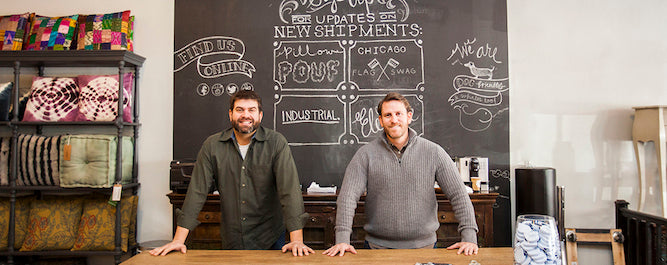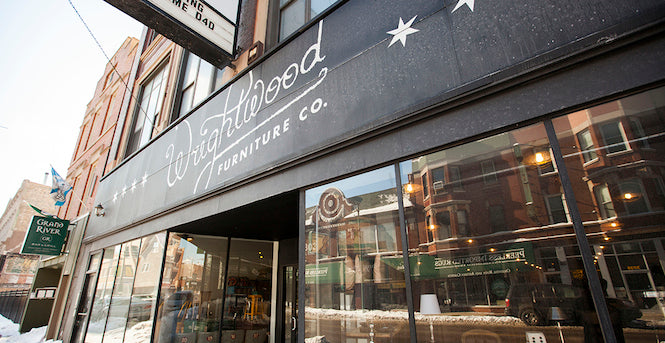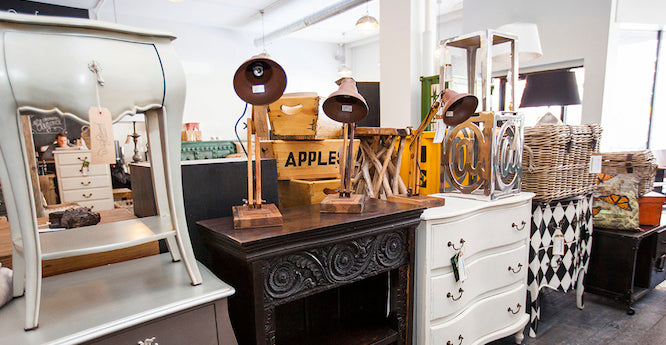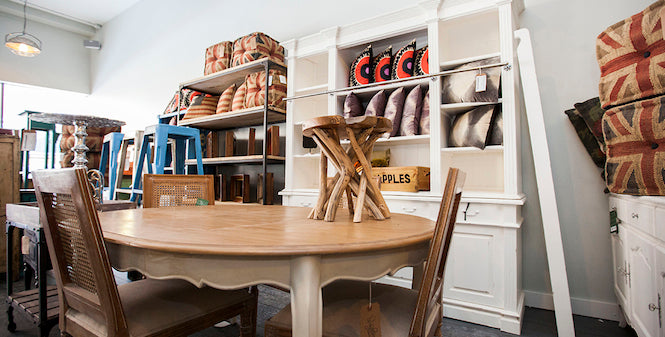Meet Mike and Doug, proud owners of Wrightwood Furniture in windy Chicago.
This father and son pair have been in the furniture business for as long as, well, let's just say a really long time. It was after spending several years in the wholesale business selling to big box retailers and watching customers pay ridiculous amounts of money for their furniture that they decided enough was enough.
First, they closely examined why there was such a huge mark-up and discovered that it was primarily because of the logistic inefficiencies of moving around and handling really large and bulky goods from warehouse to showroom and beyond. But rather than get caught up with it all, they decided to cut the middle man out and started designing, sourcing, and buying furniture that was anything but what you'd find in a big box store and having it shipped directly to their store.
They also made a firm commitment to the environment in the process. The duo only sells furniture that uses plantation-grown or recycled wood, recycled aluminum, and doubling the store as a warehouse where everything is shipped from for their online orders to reduce their carbon footprint and the number of moving parts in the operations.
And the best part? They're one of the omnichannel examples that has found early success by operating a highly successful online store in addition to their Chicago physical retail location.
I had a chance to catch up with Mike who broke down what it was like selling both online and offline and why they decided to go down that route.
Learn more: Omnichannel retailing simplified
1) Describe your business and products in 1-3 sentences

We make amazing, handmade furniture affordable for Chicagoans. We work with the best factories we can find and ship their exclusive, one-of-a-kind furniture pieces right to our store – skipping the middlemen, warehouses and unnecessary transportation costs that make furniture more expensive for customers, but not better.
There is not another store in Chicago (or anywhere for that matter) that compares to the values and quality we offer. Customers have been receptive to our model and we started turning a profit in our second month.
2) Why did you decide to do a business that's online and in the world of physical retail?

When it comes to furniture, people really want to feel a piece, to test its weight and sturdiness, to better visualize -- overall -- a place for it in their homes – and that’s especially true of our merchandise because it’s all handmade.
At the same time, we’ve found that almost all consumers want to browse online before they come in, and many are drawn to purchasing online, as well. Shopify, combined with a POS software makes it easy for merchants like us to go online and run both systems together.
Local ecommerce is a relatively new trend, so when we opened Wrightwood, we didn’t really know what to expect as far as transactions from the site itself. Last month, more than 12% of revenue came from online orders, but we believe that more than 50% of the customers who buy in the store have been looking intensely at products through the site before they visit.
3) How did you go about finding a location for your retail store?

We have a great market here in Chicago, and we worked with an experienced retail real estate broker to ensure that we capitalized on that. Retail truly is all about location, and is the single biggest expense when opening a storefront, so we took it very seriously.
4) How did you go about making decisions around store layout, visual merchandising, signage and the "look/feel" of your store?

Our products come and go quickly, and there simply isn't time or space to set up vignettes like you would see in a traditional furniture store. With that, though, we wanted to harness the feeling of walking through a Parisian flea market or a great antique store.
We wanted the customer to feel like they are on a treasure hunt, because every piece in our store is a “find.” It all lends itself to a sense of “organized chaos” – everything is sort of piled up, but artfully. We have an amazing store manager, and we don't know how he makes the place look as organized as he does.
5) How do you approach pricing with your business model?
Wrightwood is all about zeroing in on furniture with extreme value, in comparison to the other traditional, popular big box retailers out there. We are constantly engaged in the industry, comparison shopping between our competitors, and studying every item before purchasing it.
We review the brand name retailers, as well as online retailers and flash sale sites. Our policy is that any item we have must be offered at a price that is less than half of what customers would pay for a piece of similar style, make and quality at other retailers, such as Crate & Barrel, Pottery Barn or One King's Lane.
6) Where did your first batch of customers come from? Any major media mentions or PR wins since then?
We’ve run a few Facebook ads. Since we don’t do any traditional advertising, Facebook ads have been good because they allow us to target very specific demographics, including geographic targeting. We also use our personal social media pages to leverage the Wrightwood brand.
We also have a publicist, leading us to some terrific features in Daily Candy, Racked Chicago, InsideShopper.com and local lifestyle publications, including Chicago Magazine. We’ll be featured on WCIU TV’s local morning show, You & Me This Morning, later this month, as well as other TV appearances to come.
We have so much going on and the changing merchandise gives us so many opportunities to get the word out going forward.
7) What software, tools and resources are crucial to your retail business?
Obviously, Shopify has been crucial to our business. The integration between the web store and the physical store is seamless. Shopify provides us with one database with information on all our customers, orders and products. This is our first time engaging in the retail business, and we just can't imagine doing it without this technology and streamlining those two sales components.
Learn more: Omnichannel vs. multichannel
The other tool that has been critical to maintaining the success of the Wrightwood model are spreadsheets where we’re able to compile all necessary information on competitors and price comparisons. We’re also able to export Shopify sales reports into Microsoft Excel and breakdown sales by a number of categories to easily determine what styles and pieces are selling; it gives us great insight into our customers, and what kinds of styles and furniture pieces they want and are looking for.
8) What were your biggest mistakes or wastes of time and money (if any) when first starting out selling in physical retail?
Our lease required our landlord to do improvements before we moved in. For whatever reason, these improvements took much longer than expected and we opened months later than we would have liked. In hindsight, we should have had clauses to better enforce that part of the contract.
As we said, Wrightwood is all about value and we wanted that reflected in the layout and design of the store itself. For instance, the cash wrap, light fixtures and shelving all came from our factories.
9) How do you manage the inventory or supply side of your business and decide how many and which products to stock?

One key piece of advice is not to bet too heavily on any category of products until it’s proven its success. The consumers will surprise you with what they like – and what they don't. Running out of certain products is ok because you can order more later, but getting stuck with the things that don't work and aren’t selling is worse.
For us, this first year of business is all about figuring out what the customers truly want. I would tell any new retailer to be very careful about the first purchases he or she makes, and to always think of purchases as a series of tests.
10) What other key advice can you offer to ecommerce entrepreneurs looking to successfully transition into physical retail?
Running a physical store requires a lot of time and attention; it’s a full-time job. Simple things like tagging the merchandise, or cleaning the store, and not to mention setting up displays are major time-consuming tasks.
Choosing to have a physical storefront is a major undertaking, so don’t count on getting a lot of computer-based or online work done for your store during open hours. If you plan to sell internationally or nationally, think of your physical retail as a separate business or channel. Your messages are different and you may want to promote a different product mix.
For example, we developed a line of pillows and benches, designed with the Chicago flag, and those have been a huge hit in this market. Make sure you optimize for local SEO. Reach out to local bloggers and media. In reality, you are the new kid on the block and everyone will want to check you out; be sure to take advantage of that curiosity when you’re starting out and find ways to sustain interest in your business.
11) You serve mainly the Chicago area. Why did you decide to stay local?

We decided from the start that we would rather be the best solution for a given audience in a specific market, than just an “ok” solution for everybody. Furniture is very bulky and expensive to ship over long distances and requires a lot of packing – and that adds a lot to the product cost for the consumer. By importing furniture direct to our store, our prices are far better than internet only retailers like Wayfair, One King's Lane.
Even Amazon doesn't come close. However, we do receive orders online for pillows and smaller furniture items which we can have packaged at the local FedEx office and shipped. Chicago is a huge market, with about 9 million people. That's bigger than a lot of countries. We’re aiming be the best solution, serving a market of this size. For us, that’s a highly viable, long-standing business model. We plan to expand Wrightwood to other cities. Each store will be serve that city's market. We will be multi-local as opposed to national.
Are you a Shopify POS merchant with a retail success story you want to share? Tell us all about it!
